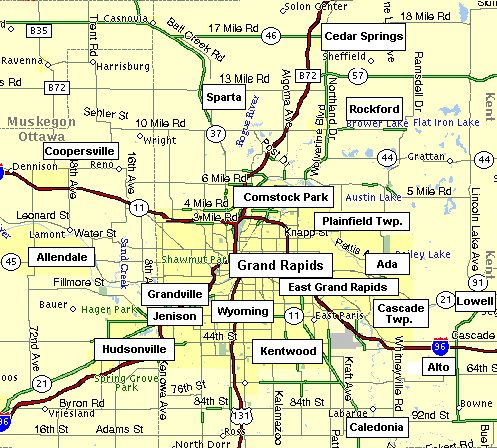The state of Michigan has demonstrated an increased propensity towards an expansive economy. In fact, the economy of Michigan has outpaced the rest of the nation and improved modestly in a short period of time. One city, in particular, helped Michigan get to where it is today: Grand Rapids. Outside of the most popular metropolitan areas on either coast, Grand Rapids has proven to be one of the hottest real estate markets in the country. The combination of affordable housing and a very respectable job market has Grand Rapids real estate in a position to prosper in 2015, and beyond. According to Zillow, the Grand Rapids housing market is very healthy.
With a median home price of $136,000; Grand Rapids real estate is considerably under the national average ($208,067). However, with strong fundamentals in place, Grand Rapids real estate has appreciated at a rate of 8.5 percent over the course of a year. That is nearly 3 percent higher than the national average over the same period. It isn’t until you go back approximately three years that the true value of Grand Rapids’ real estate is revealed. Over the past three years, homes in the Grand Rapids region appreciated at a rate of 34.6 percent, whereas the national average was just over 28 percent.
Appreciation in the Grand Rapids housing market has boosted activity. Homeowners were permitted to sell and still feel confidante in finding affordable housing elsewhere. The following highlights how much equity has been gained relative to the year of the home’s purchase:
- Homes purchased in the Grand Rapids housing market one year ago have appreciated, on average, by $12,625. The national average was $14,170 over the same period.
- Homes purchased in the Grand Rapids housing market three years ago have appreciated, on average, by $40,289. The national average was $53,857 over the same period.
- Homes purchased in the Grand Rapids housing market five years ago have appreciated, on average, by $53,811. The national average was $48,036 over the same period.
- Homes purchased in the Grand Rapids housing market seven years ago have appreciated, on average, by $24,085. The national average was $13,870 over the same period.
- Homes purchased in the Grand Rapids housing market nine years ago have appreciated, on average, by $18,948. The national average actually decreased $2,822 over the same period.
The Grand Rapids real estate market has benefited from the local job sector. In fact, with such a promising economic outlook in the area, jobs should continue to drive supply and demand for the foreseeable future. Of particular importance, however, is the city’s unemployment rate. Unemployment in Grand Rapids is significantly better than the national average, at 3.6 percent and 5.6 percent respectively. To get to 3.6 percent, unemployment managed a drop of more than 2 percent in the last 12 months. Perhaps even more encouragingly, the city’s job growth rate has reached 3.9 percent, two whole percentage points higher than the national average. Local employment growth is very strong compared to most other markets. In addition to a very progressive job sector, Grand Rapids has one more factor working strongly in its favor: affordability. Grand Rapids is, in fact, more affordable than most markets across the country. On average, owners in the Grand Rapids housing market dedicate 7.6 percent of their income to monthly mortgage payments, which is about half of the national average.
Strong demographic and economic fundamentals have encouraged new construction in the Grand Rapids housing market. The current level of construction is now 63.7 percent above the long-term average for the area. The jump in construction can be attributed to single-family housing permits, which saw a 48.9 percent increase over the course of a year. The addition of these new homes should stabilize inventory and allow for a healthy market to flourish.
Grand Rapids real estate investing should see more foreclosure activity. According to RealtyTrac, the city has 577 foreclosures in some stage of default (default, auction or bank owned). That number increased 38 percent over the course of a month and 30 percent from this time last year. However, it is the foreclosure discount that will really help Grand Rapids real estate investing. The median sales price of a non-distressed property was approximately $115,000. Conversely, the median sales price of foreclosures was $60,500, or 47% lower than non-distressed home sales. That is a savings of about $54,500 for Grand Rapids real estate investors.
Of the foreclosures on today’s Grand Rapids housing market, 59.2 percent are to be put up for auction. That number represents an 18.3 percent increase over last year. The rest of the foreclosures are bank-owned.
Those interested in Grand Rapids real estate investing are advised to familiarize themselves with the area’s most popular neighborhoods. Fortunately, Trulia has already identified the neighborhoods that receive the most attention:
- Creston
- West Grand
- Westside Connection
- South East End
- Garfield Park
Of those that made the list, Creston and West Grand are the most popular – at least according to Trulia. Grand Rapids real estate investors may want to use these neighborhoods as a control, as to gauge subsequent markets.
While the Grand Rapids housing market is not quite on par with cities like San Diego and San Jose, it has certainly gained a lot of traction in the current rebound. In fact, the city has gained enough momentum to be considered one of the hottest housing markets in the country. A combination of strong fundamentals and economic indicators has made this area very enticing to real estate investors. In fact, Grand Rapids real estate investing should make a lot of progress in the coming year. Investors can expect positive trends to continue.
Grand Rapids Housing Market Summary:
- Current Median Home Price: $136,900
- 1-Year Appreciation Rate: 8.5%
- Unemployment Rate: 3.6%
- 1-Year Job Growth Rate: 3.9%
- Population: 192,294
- Median Household Income: $52,485

